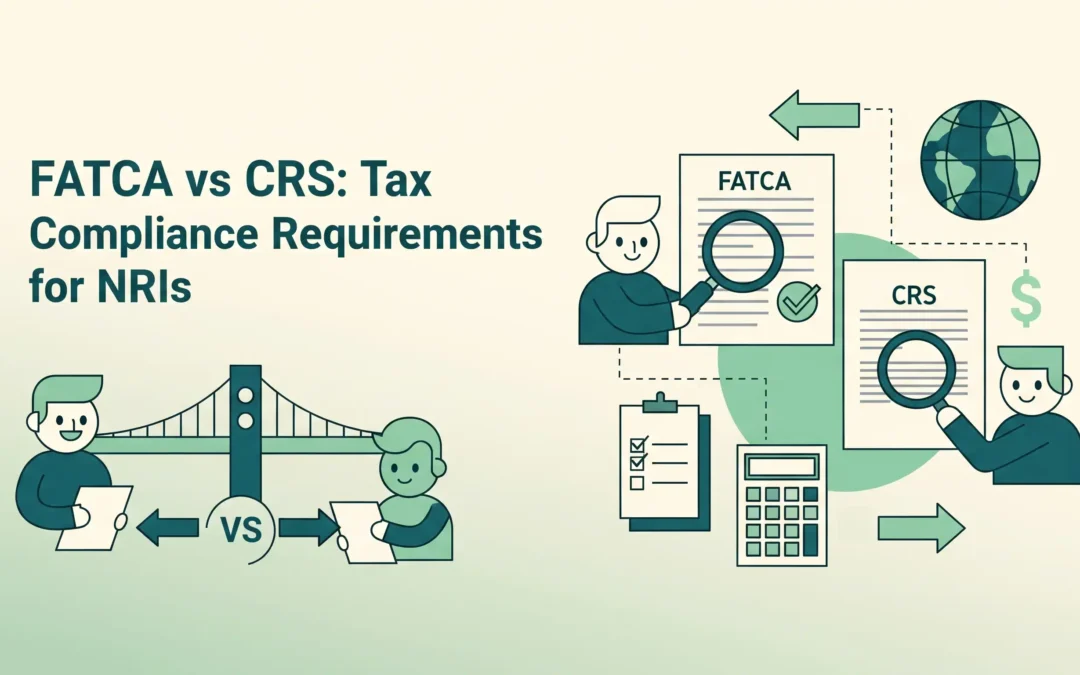Understanding taxation is a difficult task for most individuals. Not everyone relies on CAs for filing their returns and understanding various financial terms. There are different types of regulations and standards in taxation developed by different bodies. Two of them are FATCA and CRS, developed by the US government and OECD, respectively.
This article contains a detailed description of FATCA and CRS, which will help you understand their meanings, features, and the clear distinction between them. Let us dive into the topic.
What is FATCA?
The Foreign Account Tax Compliance Act (FATCA) is a federal law in the United States that was first introduced in 2010. Its goal is to prevent Americans with assets in foreign accounts from evading taxes. In order to comply with FATCA, India and the United States signed an agreement in 2015. This agreement requires Indian financial institutions to report specific account information to the U.S. IRS.
Key Features:
- Applicability: U.S. persons include citizens, green card holders, and U.S.-based companies that have accounts abroad.
- Financial Institution Reporting: Through the Indian government, Indian banks, mutual funds, and insurance companies are required to submit account information to the IRS.
- Self-Declaration Needed: Individuals in the United States are required to disclose their tax identification number (TIN) on Form W-9.
- Withholding Penalties: Those who don’t comply may be subject to a 30% withholding tax on payments made from sources in the United States.
- Account Action: Financial institutions may freeze or close accounts for non-disclosure.
What is CRS?
The Organisation for Economic Co-operation and Development (OECD) created the Common Reporting Standard (CRS) in 2014 to establish a global framework for the automatic sharing of financial data between nations. India is one of more than 100 nations that have vowed to use CRS to combat tax evasion and advance transparency.
Key Features:
- Applies Worldwide: CRS targets tax residents not only in the United States but in any participating nation.
- Annual Data Exchange: The Central Board of Direct Taxes (CBDT) receives information from Indian financial institutions and forwards it to international tax authorities.
- Self-Certification Required: NRIs are required to use Form 61B or its equivalent to reveal their country of tax residence.
- Essential Information: Name, address, TIN, account number, balance, and income received on the account are among the details shared.
- Repercussions for Non-Compliance: Depending on local laws, account closure or restrictions may result.
Comparison Between FATCA and CRS
Let us discuss the difference between FATCA and CRS:
1. History and Objective
The United States passed FATCA in 2010 as part of the HIRE Act. Its only goal is to find American taxpayers who are concealing their wealth in foreign accounts and make sure they pay the taxes that are due.
In contrast, the OECD started the global initiative known as CRS in 2014. Its goal is to deter international tax evasion by allowing participating nations to automatically exchange financial account information of each other’s tax residents.
2. Relevance and Extent
FATCA is only applicable to U.S. citizens, U.S. tax residents, green card holders, and U.S.-based entities, regardless of where they live.
Anyone who meets the requirements to be considered a tax resident of a participating CRS country is subject to CRS. This includes NRIs who live in nations such as the United Kingdom, the United Arab Emirates, Canada, Australia, etc.
3. Types of Contracts
The United States and each of its partner nations have bilaterally signed Intergovernmental Agreements (IGAs) that enforce FATCA.
Every participating nation in CRS agrees to a common reporting and exchange standard, and the program operates on a multilateral platform.
4. Data Gathered and Disseminated
Financial institutions are required by FATCA to report:
- Address and name
- Taxpayer Identification Number (TIN) for the United States
- Number of accounts
- Balance of account
- Income from dividends, interest, etc.
The data exchanged under CRS consists of:
- Name, residence, and birthdate
- Number of Tax Identification (TIN)
- Country of residence for taxes
- Number of accounts
- Details of income and account balance
5. Procedure for Reporting
FATCA: The U.S. IRS receives FATCA data from Indian banks and financial institutions after it is reported to the Indian tax authorities (CBDT).
CRS: In accordance with the applicable CRS agreements, Indian institutions gather data pertaining to CRS and forward it to the CBDT, which subsequently distributes the data to other foreign tax authorities.
The table below summarizes the difference between FATCA and CRS:
| Feature | FATCA | CRS |
| Developed by | U.S. Government (IRS) | OECD (Global Standard) |
| Year Introduced | 2010 | 2014 |
| Applicability | U.S. citizens, green card holders | Tax residents of CRS-participating countries |
| Type of Agreement | Bilateral IGAs | Multilateral agreement |
| Data Recipient | U.S. IRS | Tax authorities of respective countries |
| Forms Required | W-9 / W-8BEN | Self-certification / Form 61B |
| Penalty for Non-Compliance | 30% Withholding, Account Freeze | Local penalties, account suspension |
| India Adoption | 2015 | 2016 |
Bottomline
The conclusion can be drawn that both FATCA and CRS have their own implications. India adopted them in the year 2015 and 2016, respectively. They have a different procedure in which they operate, and relevant. FATCA is specific to citizens of the United States, especially people who hold a green card. While CRS is on a global level applicable to citizens of all countries that come under this agreement.
It is important to be aware of such topics not only for people in the field of finance but also for everyone dealing with their personal finances.


